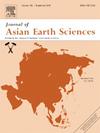塔里木盆地顺脱郭勒低凸起超深层海相天然气成因与成藏模式
IF 2.7
3区 地球科学
Q2 GEOSCIENCES, MULTIDISCIPLINARY
引用次数: 0
摘要
塔里木盆地是中国最大的叠合含油气盆地之一,勘探水平相对较低。顺北-顺南地区近年来的勘探进展凸显了超深层海相天然气的巨大潜力。然而,超深海天然气的成因、蚀变和成藏模式的不确定性极大地阻碍了未来的油气勘探。系统分析了顺北-顺南地区超深层海相天然气地球化学特征及成因。结果表明,本区天然气既有原生气,也有原油裂解气。其中,顺北地区天然气以油伴生为主,以一次裂解气为主,油裂解气贡献较小;顺南地区天然气以油裂解气为主。海相天然气成熟度各不相同,满加尔坳陷附近较高,越远越低。随着距离满加尔坳陷的增加,高成熟干气、凝析油气、挥发油、轻质油依次分布,气油比逐渐降低。顺北—顺南地区海相天然气经历了裂解、热化学硫酸盐还原、热液蚀变等多种蚀变作用。顺南地区烃蚀变较顺北地区更为明显。顺北—顺南地区走滑断裂的活跃期与烃源岩的主要生排烃期相吻合。走滑断裂是油气运移的重要通道,使油气垂直运移进入中上奥陶统储层,形成主要的储集空间。本文章由计算机程序翻译,如有差异,请以英文原文为准。
Origin and accumulation model of ultra-deep marine natural gas in the Shuntuoguole low Uplift of the Tarim Basin, NW China
The Tarim Basin, with its relatively low level of exploration, is one of China’s largest superimposed petroliferous basins. Recent exploration advancements in the Shunbei-Shunnan area highlight the significant potential for ultra-deep marine natural gas. However, uncertainties surrounding the origin, alteration, and accumulation models of ultra-deep marine natural gas have greatly hindered future hydrocarbon exploration. This study systematically analyzes the geochemical characteristics and genesis of ultra-deep marine natural gas in the Shunbei-Shunnan area. Results indicate that the natural gas in this region comprises both primary and oil-cracking gases. Specifically, the Shunbei area’s natural gas is primarily oil-associated, dominated by primary cracking gas with minor contributions from oil-cracking gas, whereas the Shunnan area’s natural gas is predominantly oil-cracking gas. The maturity of marine natural gas varies, being higher near the Manjiaer Depression and relatively lower farther away. A sequential distribution of highly mature dry gas, condensate oil and gas, volatile oil, and light oil, accompanied by a gradual decrease in gas–oil ratio, is observed with increasing distance from the Manjiaer Depression. The marine natural gas in the Shunbei-Shunnan area has undergone various alterations, including cracking, thermochemical sulfate reduction, and hydrothermal fluid alteration. Hydrocarbon alteration is more pronounced in the Shunnan area than in the Shunbei area. The active period of strike-slip faults in the Shunbei-Shunnan area coincides with the major hydrocarbon generation and expulsion phases of the source rock. These strike-slip faults serve as critical conduits for hydrocarbon migration, enabling oil and gas to migrate vertically into the middle and upper Ordovician reservoirs, where they form the primary reservoir spaces for accumulation.
求助全文
通过发布文献求助,成功后即可免费获取论文全文。
去求助
来源期刊

Journal of Asian Earth Sciences
地学-地球科学综合
CiteScore
5.90
自引率
10.00%
发文量
324
审稿时长
71 days
期刊介绍:
Journal of Asian Earth Sciences has an open access mirror journal Journal of Asian Earth Sciences: X, sharing the same aims and scope, editorial team, submission system and rigorous peer review.
The Journal of Asian Earth Sciences is an international interdisciplinary journal devoted to all aspects of research related to the solid Earth Sciences of Asia. The Journal publishes high quality, peer-reviewed scientific papers on the regional geology, tectonics, geochemistry and geophysics of Asia. It will be devoted primarily to research papers but short communications relating to new developments of broad interest, reviews and book reviews will also be included. Papers must have international appeal and should present work of more than local significance.
The scope includes deep processes of the Asian continent and its adjacent oceans; seismology and earthquakes; orogeny, magmatism, metamorphism and volcanism; growth, deformation and destruction of the Asian crust; crust-mantle interaction; evolution of life (early life, biostratigraphy, biogeography and mass-extinction); fluids, fluxes and reservoirs of mineral and energy resources; surface processes (weathering, erosion, transport and deposition of sediments) and resulting geomorphology; and the response of the Earth to global climate change as viewed within the Asian continent and surrounding oceans.
 求助内容:
求助内容: 应助结果提醒方式:
应助结果提醒方式:


